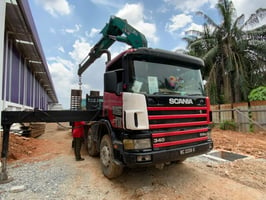Towing isn’t just about horsepower or hitch ratings—it’s about confidence, control, and the peace of mind that comes with knowing your gear is in top condition.
When you invest in the ProPride 3P Sway Eliminating Hitch, you’re choosing one of the most advanced, dependable towing systems on the market. Its precision engineering, sway control, and weight distribution technology make it a favorite among serious haulers. But even the best equipment requires consistent care to perform at its peak—and that’s where smart maintenance habits make all the difference.
Whether you're a full-time traveler or a weekend explorer, routine upkeep helps prevent wear, extends the life of your hitch, and ensures every trip is as safe as the last. Don’t wait for a breakdown or warning sign—stay ahead with proactive maintenance.
In this blog, you’ll learn:
- Smart habits to reduce wear and avoid expensive repairs
- How to fine-tune and adjust your ProPride 3P Hitch
- Quick ways to extend the life of key components
Let’s get into the maintenance checklist every hitch owner should follow.
Routine Visual Inspections: Catching Potential Issues Early
Before diving into tools or lubrication, start with your most valuable asset: your eyes.
Take five minutes before and after each trip to scan your entire hitch system, checking for:
- Cracks or stress marks on the hitch head
- Signs of rust or corrosion on bolts and bars
- Loosened hardware or missing pins
- Fraying safety chains or cables
Make it a habit, not an afterthought. Early detection of damage prevents bigger problems later—and can mean the difference between a smooth haul and an unexpected stop on the side of the road.
Proper Lubrication: Ensuring Smooth and Efficient Operation
Lubrication is essential for the smooth and efficient operation of your ProPride 3P Hitch.
Properly lubricating all moving parts reduces friction, wear, and noise. Lubricate the hitch ball, trunnion bars, and other moving parts periodically using a high-quality lubricant, such as lithium-based grease.
Also, consider using a hitch ball cover when not towing to protect the lubricated hitch ball from dirt and debris.
Hardware Tightening: Maintaining Optimal Tension for Safety
As you tow, vibrations and road movement naturally loosen nuts and bolts. A loose hitch system can create instability and increased sway—two things you don’t want at highway speeds.
Every few trips—or monthly for frequent haulers—use a torque wrench to inspect and tighten:
- Hitch head bolts
- Frame brackets
- Sway control linkages
- Weight distribution jack attachments
Always follow the torque specs provided in your ProPride 3P user manual. Both under-tightening and over-tightening can reduce component longevity and compromise safety.
Fine-Tuning Your Setup: Adjustments That Matter
Your towing configuration isn’t static. Trailer weight, tow vehicle changes, and gear loadouts all affect performance. Revisit and adjust your hitch setup when needed, focusing on:
- Hitch head angle – Should keep the trailer level or slightly nose-down.
- Weight distribution jacks – Adjust tension for balanced load across axles.
- Trunnion bar position – Ensure both bars are evenly engaged for sway control.
A tape measure and level go a long way in helping you visually confirm a balanced setup. Make changes slowly and test at low speeds.
Cleaning and Corrosion Prevention: Prolonging the Life of Your Hitch
Keeping your hitch system clean and free from dirt, debris, and corrosion is crucial for prolonging its life and maintaining optimal performance.
After each trip, especially in harsh environments or during winter months, clean your hitch components using mild soap and water. Make sure to dry the parts afterward to prevent rust or corrosion thoroughly.
Applying a coat of high-quality automotive wax can further protect your hitch system from the elements and keep it looking its best.
Replacing Worn Components: Know When It’s Time
Even the most rugged hitches wear out over time. Ignoring wear signs puts you—and others on the road—at risk.
Keep an eye out for:
- Cracks or rust on the hitch ball or trunnion bars
- Fatigue or deformation in pins, bolts, or brackets
- Unusual noises or vibration, which can signal component misalignment or failure
Replace worn parts immediately, and always use genuine ProPride 3P components. Off-brand alternatives might not meet the same safety tolerances or fit properly.
Create a Maintenance Schedule (and Stick to It)
Consistency is key. Use a maintenance checklist to ensure no step is missed:
|
Task |
Frequency |
|
Visual inspection |
Before & after each trip |
|
Lubrication |
Every 1–2 trips |
|
Hardware tightening |
Monthly |
|
Setup adjustments |
Seasonally or after changes |
|
Cleaning & corrosion care |
After every trip |
|
Component inspection |
Monthly |
Track your maintenance in a digital note or journal. A quick log helps you stay organized and spot wear patterns over time.
Final Thoughts: Make Maintenance a Habit, Not a Hassle
Safe towing starts with the right hitch, but it continues with regular care.
When you keep your ProPride 3P system clean, tightened, lubricated, and properly adjusted, you’re not just protecting your investment—you’re ensuring the safety of everyone in your vehicle and on the road around you.
From routine inspections to strategic upgrades, every step you take adds up to longer-lasting performance and more enjoyable towing experiences.
Want to take it a step further? Explore our ProPride Owner Resources for setup guides, video tutorials, and more ways to get the most out of your hitch system.
Frequently Asked Questions
Even seasoned ProPride 3P owners have questions that go beyond regular maintenance. Below are answers to common concerns that can help you get even more peace of mind while towing.
How do I know if my weight distribution jacks are working correctly?
Your trailer should sit level, with minimal bounce or sway while towing. If you notice uneven tire wear, trailer sagging, or bouncing during braking or turns, it's time to check the tension and positioning of your weight distribution jacks for possible adjustments.
Can I use pressure washing to clean my hitch system?
Avoid high-pressure washers. They can force water into joints, remove grease, and damage paint. Stick to hand washing with mild soap and water, followed by thorough drying. A soft brush helps clean tight areas without damaging the finish or protective layers on your hitch.
Is it okay to leave my hitch exposed to the elements?
It’s safe for short periods, but long-term exposure can cause rust, fading, and premature wear. Use a protective cover or store your hitch indoors when not in use. Apply rust-inhibiting spray before extended off-season storage to protect vulnerable areas from corrosion.
Should I grease the inside of the receiver tube?
No, greasing the inside of the receiver tube attracts dust and debris, which can lead to grinding and wear over time. Instead, keep it clean and dry. If rust is a concern, apply a light coat of anti-corrosion spray and wipe off excess.
What’s the best way to store my hitch in the off-season?
Start by cleaning the entire hitch system and drying it completely. Apply a rust preventative or wax to exposed metal parts. Then, store it off the ground in a dry, temperature-controlled area. Avoid humid environments or direct sunlight to extend its usable life.
How do I spot early signs of sway before it becomes dangerous?
Early sway signs include subtle fishtailing, excessive steering input, or drifting at highway speeds. These indicate a need to rebalance your load or check hitch settings. Address issues promptly, especially in windy conditions or when driving downhill with added momentum.


